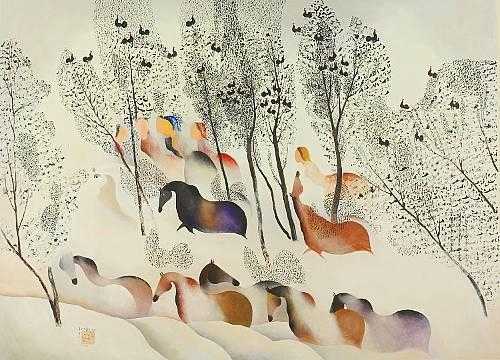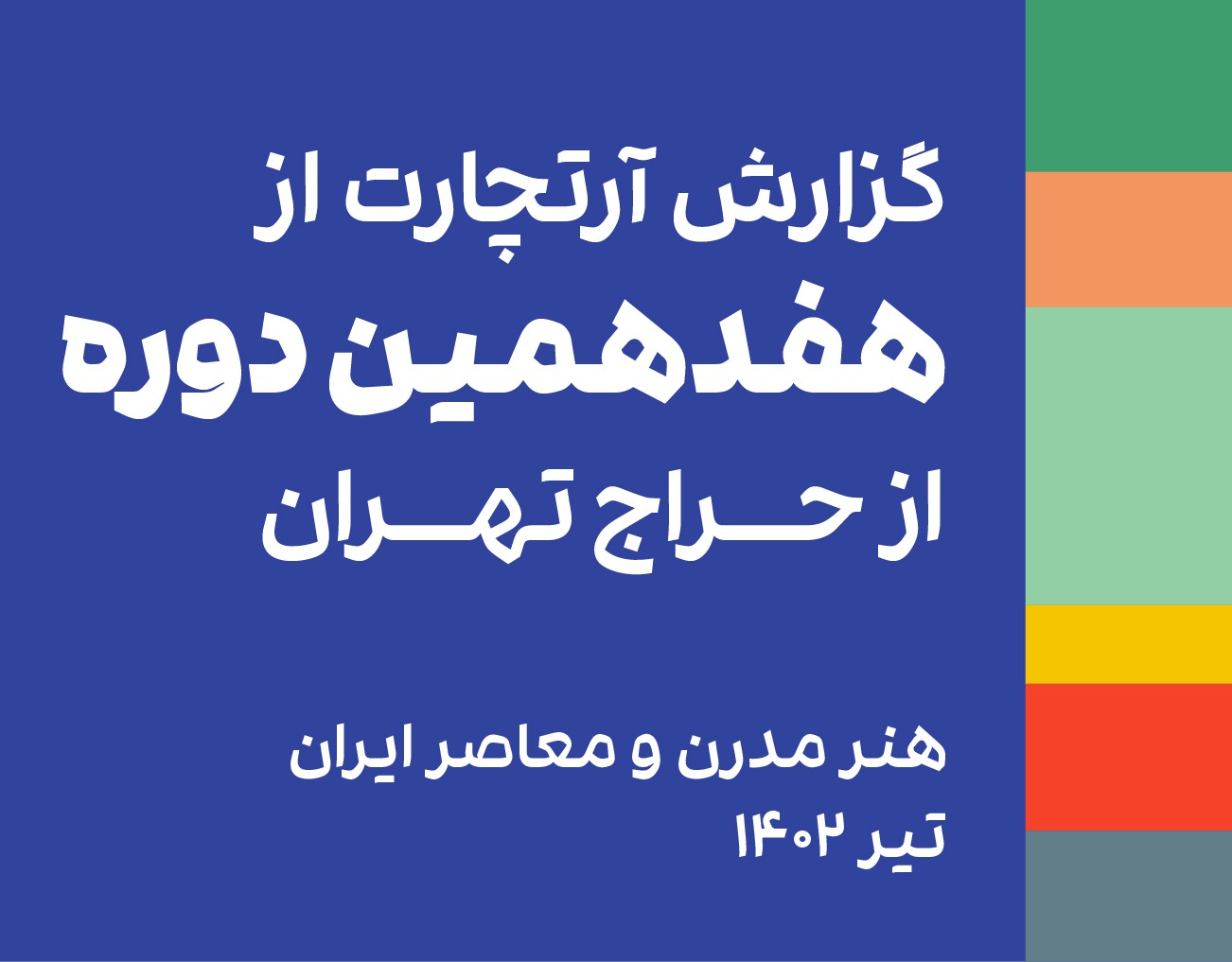About Mohammad Ali Taraghijah
Mohammad Ali Taraghijah, an Iranian painter celebrated for his modernist approach and self-taught talent, initially pursued studies in mechanical engineering before dedicating himself to painting. His artistic journey took a significant turn when he won the gold medal in Iranian universities' art competitions in 1967, prompting him to fully embrace his passion.
In 1971, Taraghijah held his inaugural solo exhibition at Tehran Gallery, marking the beginning of his international presence with participation in the 1971 Basel International Art Exhibition in Switzerland. Subsequently, his art gained acclaim globally, with frequent exhibitions in prestigious venues across cities like New York, Tokyo, Delhi, Beijing, Paris, Zurich, and Stuttgart. In 1998, the International Museum of 21st Century Art recognized his contributions to Iranian art.
Taraghijah passed away in 2010 at the age of 67, leaving behind a legacy of profound artistic exploration. His notable works are housed in esteemed institutions such as the International Museum of 21st Century Art in the United States, Sharjah Museum of Modern Art, Rotterdam World Museum, and Tehran Museum of Contemporary Art.
Initially rooted in realism, Taraghijah's style evolved towards mental abstraction and modernism from the mid-1970s onwards. His art embraced simplicity with naïve and poetic elements, integrating influences from Iranian painting and calligraphy. By the 1980s, he developed a distinctive visual language, notably featuring abstract depictions of horses inspired by Iranian art motifs. Using warm brown, ink, and acrylic tones, Taraghijah created pieces evoking desert-like atmospheres, often incorporating folkloric themes such as plants, roosters, horses, and women. Some of his artworks include Sufi poems, enriching their poetic essence with references to literary and mystical traditions.
Eberhard Frank, a painter and university professor, likened Taraghijah's artworks to the quatrains of Khayyam, describing them as weightless, suspended in space, leaving a lasting impression akin to cherished old letters. Sabin Naqdi Daveh, an art history professor and former Sotheby's expert, praised the harmonious relationship between Taraghijah's paintings and the tangible world. He noted Taraghijah's ability to translate reality into serene compositions adorned with beautifully stylized designs set against uniform backgrounds.
In 1971, Taraghijah held his inaugural solo exhibition at Tehran Gallery, marking the beginning of his international presence with participation in the 1971 Basel International Art Exhibition in Switzerland. Subsequently, his art gained acclaim globally, with frequent exhibitions in prestigious venues across cities like New York, Tokyo, Delhi, Beijing, Paris, Zurich, and Stuttgart. In 1998, the International Museum of 21st Century Art recognized his contributions to Iranian art.
Taraghijah passed away in 2010 at the age of 67, leaving behind a legacy of profound artistic exploration. His notable works are housed in esteemed institutions such as the International Museum of 21st Century Art in the United States, Sharjah Museum of Modern Art, Rotterdam World Museum, and Tehran Museum of Contemporary Art.
Initially rooted in realism, Taraghijah's style evolved towards mental abstraction and modernism from the mid-1970s onwards. His art embraced simplicity with naïve and poetic elements, integrating influences from Iranian painting and calligraphy. By the 1980s, he developed a distinctive visual language, notably featuring abstract depictions of horses inspired by Iranian art motifs. Using warm brown, ink, and acrylic tones, Taraghijah created pieces evoking desert-like atmospheres, often incorporating folkloric themes such as plants, roosters, horses, and women. Some of his artworks include Sufi poems, enriching their poetic essence with references to literary and mystical traditions.
Eberhard Frank, a painter and university professor, likened Taraghijah's artworks to the quatrains of Khayyam, describing them as weightless, suspended in space, leaving a lasting impression akin to cherished old letters. Sabin Naqdi Daveh, an art history professor and former Sotheby's expert, praised the harmonious relationship between Taraghijah's paintings and the tangible world. He noted Taraghijah's ability to translate reality into serene compositions adorned with beautifully stylized designs set against uniform backgrounds.
The Most Expensive Artwork
At Auctions
First Attendance
31 October 2007
# Attendance
30
# Artworks
34
Average Realized Price
27,604 USD
Average Min Estimate
16,483 USD
Average Max Estimate
22,974 USD
Sell-through Rate
84.848%
Average Growth of Artwork Worth
39.088%
Timeline
Artibition Auction - Dec 2025 auction
12 December
Continuum: The Unbroken Line of Persian Art exhibition
2 November
Artibition Auction - October 2025 auction
7 October
CHARSOO- Part 2 exhibition
3 October
The 24th Tehran - Contemporary Iranian Art auction
3 October
Charsoo exhibition
5 September
Shadow exhibition
18 April
Fragments of Persian Modernity: Selected pieces from Iranian Modern and Contemporary Art exhibition
13 April
Noble Sale: Ducal Treasures auction
19 March
FINE FOLK OUTSIDER auction
18 November
The Pioneers of Modern Iranian Art Vol.3 exhibition
24 August
Resize exhibition
16 August
"Bitter, Sweet, Burden" Iranian Perspective, Three Views exhibition
9 August
The 20th Tehran- Modern and Contemporary Iranian Art auction
5 July
Artibition auction
7 June
Artibition Auction - March 2024 auction
11 March
10s of Artworks, 10s of Millions exhibition
8 March
The Artwork of Legendary Artists exhibition
9 February
Fantastic Stories exhibition
9 February
In Water Color exhibition
2 February
The 19th Tehran -Classic and Modern Iranian Art auction
24 January
Gozar Project exhibition
19 January
Modern Collectore exhibition
19 January
Arthibition auction
20 October
Collector - Modern exhibition
29 September
The 17th Tehran Modern and Contemporary Iranian Art auction
18 July
Figure exhibition
23 June
resize exhibition
13 April
Recovery/ The third series exhibition
10 March
Collector exhibition
15 February
Weightlessness exhibition
2 February
Lotfi x Mashahir Cross 2 exhibition
9 September
Art Closer Than Ever exhibition
26 August
Tehran- 16th- Iranian contemporary art auction
1 July
Modern Collector exhibition
24 June
Resize exhibition
13 May
Nowruz Festival of Rivers exhibition
10 March
The last event 1400 exhibition
25 February
Opportunity exhibition
13 February
Mirror reflections exhibition
19 January
The 15th Tehran- Modern Iranian Art auction
14 January
10th Collector exhibition
7 January
Modern Artists exhibition
29 October
From Object to Figure exhibition
24 September
No.9 auction
3 September
8th Collector exhibition
9 July
Small Artworks collection exhibition
11 June
Gathered exhibition
22 March
Collector 7 exhibition
5 February
Souvenir exhibition
2 February
The 13th Tehran- Modern and Contemporary Iranian Art auction
15 January
No.8 auction
1 January
No.6 auction
16 October
Archive exhibition
21 August
Show and Sell of Works for the Benefit of Corona Patients exhibition
24 April
100 Works, 100 Artists Online Exhibition exhibition
2 August
Up to 10 Million exhibition
8 February
دهمین دوره حراج تهران auction
11 January
The Color of the Sky exhibition
30 November
The Fourth Annual Auction of Behnam Daheshpour Gallery exhibition
28 June
هشتمین دوره حراج تهران auction
12 January
Retrospective exhibition
17 February
The 6th Tehran- Contemporary Iranian Art auction
23 December
Paintings of Mohammad Ali Tarqijeh exhibition
31 July
United Nations World Food Programme - Charity auction
30 April
Modern & Contemporary Arab, Iranian and Turkish Art Part II auction
24 October
International Modern & Contemporary Art auction
27 October
Art Moderne et Contemporain Iranien et Arabe auction
24 October
Modern & Contemporary Middle Eastern & South Asian Art auction
3 June
International Modern & Contemporary Art auction
29 April
Modern & Contemporary Arab, Iranian, Indian & Pakistani Art auction
24 November
International Modern and Contemporary Art auction
30 April
Modern & Contemporary Arab, Iranian, Indian & Pakistani Art auction
3 March
International Modern & Contemporary Art auction
31 October
Articles
۱7th Tehran Auction Sales Report 26 July 2023
The 17th Tehran auction: modern and contemporary, was held on Friday July 21st, 2023 at Parsian Azadi Hotel. This auction achieved a total sale of 214 billion tomans equivalent to 4.3 million dollars, which was a growth of 77.8% compared to the previous period. Artchart has observed the 17th Tehran auction in the upcoming report.

